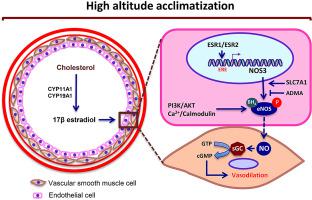Nitric Oxide ( IF 3.2 ) Pub Date : 2020-06-13 , DOI: 10.1016/j.niox.2020.05.003 Pooja 1 , Manish Sharma 1 , Krishan Singh 2 , Gidugu Himashree 3 , Gopinath Bhaumik 1 , Bhuvnesh Kumar 1 , Niroj Kumar Sethy 1

|
Higher levels of circulatory nitric oxide (NO) and NO metabolites reportedly facilitate high altitude acclimatization. But the underlying factors and molecular pathways promoting NO production at high altitude has been poorly characterized. Studying healthy lowlanders at sea level (C, lowlander) and high altitude (3500 m, after day 1, 4 and 7 of ascent), we report higher protein levels of eNOS and eNOSSer1177, higher plasma levels of BH4, NOx (nitrate and nitrites), cGMP and lower levels of endogenous eNOS inhibitor ADMA during healthy high altitude acclimatization. Our qRT-PCR-based gene expression studies identified higher levels of eNOS/NOS3 mRNA along with several other eNOS pathway genes like CALM1, SLC7A1 and DNM2. In addition, we observed higher mRNA levels of estrogen (E2) receptors ERα/ESR1 and ERβ/ESR2 at high altitude that transcriptionally activates NOS3. We also observed higher mRNA level of membrane receptor ERBB2 that phosphorylates eNOS at Ser1177 and thus augments NO availability. Evaluating E2 biosynthesis at high altitude, we report higher plasma levels of CYP11A1, CYP19A1, E2, lower levels of testosterone (T) and T/E2 ratio as compared to sea level. Correlation studies revealed moderate positive correlation between E2 and NOx (R = 0.68, p = 0.02) after day 4 and cGMP (R = 0.69, p = 0.02) after day 7 at high altitude. These findings suggest a causative role of E2 and its receptors ESR1 and ESR2 in augmenting eNOS activity and NO availability during healthy high altitude ascent. These results will aid in better understanding of NO production during hypobaric hypoxia and help in designing better high altitude acclimatization protocols.
中文翻译:

雌激素受体(ESR1 和 ESR2)介导的 eNOS-NO-cGMP 通路激活促进高海拔适应。
据报道,较高水平的循环一氧化氮 (NO) 和 NO 代谢物有助于高海拔适应。但在高海拔地区促进 NO 产生的潜在因素和分子途径的特征还很差。在海平面(C,lowlander)和高海拔(3500 m,在上升的第 1、4 和 7 天后)研究健康的低地人,我们报告 eNOS 和 eNOS Ser1177 的蛋白质水平较高,BH 4、NOx(硝酸盐)的血浆水平较高和亚硝酸盐)、cGMP 和较低水平的内源性 eNOS 抑制剂 ADMA 在健康的高海拔适应过程中。我们基于 qRT-PCR 的基因表达研究确定了更高水平的 eNOS / NOS3 mRNA 以及其他几种 eNOS 通路基因,如CALM1、SLC7A1和DNM2。此外,我们在高海拔地区观察到雌激素 (E2) 受体 ERα/ ESR1和 ERβ/ ESR2 的mRNA 水平较高,可转录激活NOS3。我们还观察到膜受体ERBB2 的更高 mRNA 水平,其在 Ser1177 处磷酸化 eNOS,从而增加 NO 可用性。评估高海拔 E2 的生物合成,我们报告与海平面相比,CYP11A1、CYP19A1、E2 的血浆水平更高,睾酮 (T) 和 T/E2 比值更低。相关性研究显示,在高海拔地区,第 4 天后 E2 和 NOx(R = 0.68,p = 0.02)和 cGMP(R = 0.69,p = 0.02)之间呈中度正相关。这些发现表明 E2 及其受体的致病作用ESR1和ESR2在健康的高海拔上升过程中增强 eNOS 活动和 NO 可用性。这些结果将有助于更好地了解低压缺氧期间 NO 的产生,并有助于设计更好的高海拔适应方案。











































 京公网安备 11010802027423号
京公网安备 11010802027423号